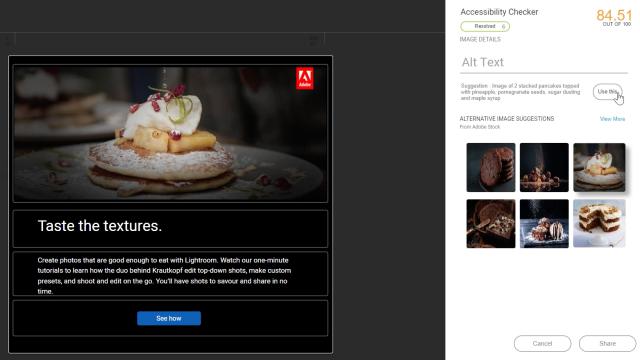A good web designer ensures that a site looks nice and functions properly across various devices and browsers. A great web designer, however, also ensures the site is accessible to all who visit, including those with visual impairments or disabilities like dyslexia. Assuring full accessibility can be a challenge, but a new tool from Adobe could make fixing a website as easy as using a spell checker to improve grammar.
Website accessibility isn’t just a courtesy to visitors. Domino’s Pizza in the U.S. is currently in a Web Content Accessibility Guidelines (WCAG) in explicit detail. The information is out there, but implementing it properly on a site can be just as big a job as squashing bugs, which is why Adobe wants to make WCAG compliance a more automated task.
Every year the company encourages it employees to think outside the box and come up with new ways to harness Adobe’s tools for innovative uses, and seven of those projects are selected and shared with the public as official Sneaks during the Adobe Summit conference, which was understandably cancelled earlier this year. The company is just now starting to reveal the winning Sneaks projects for 2020, and while they’re all still in the R&D phase, in the past many of these tools have eventually found their way into the company’s official products.
Watching the Accessibility Tool for the Web in action makes the tool look deceptively simple. It’s designed to function as either an add-on for existing software that’s used to create online content such as websites, newsletters, or other rich content delivered through emails, or serve as a standalone tool. Using a back-end AI not unlike Adobe Sensei (which is what the company uses for its commercially available products) the tool scans a website or email looking for potential issues with colour contrast, text spacing, or missing descriptions for visual content like images.
The assets are given an accessibility score out of 100, which includes details about what parts might not be compliant with the WCAG guidelines. But the checker doesn’t just leave a web developer or content creator to their own devices when it comes to improving WCAG compatibility. The same AI that’s used to automatically spot them can also, in many cases, automatically fix them.
That includes changing the colour of text or other objects to improve the overall contrast and legibility, and ensuring proper tags have been included that tell screen reading software what language the assets are in so that text content is read aloud properly. For users with visual impairments or challenges, screen reading software is the only tool they have for accessing a website, and including descriptive tags for elements can be crucial for facilitating navigation without actually being able to see the page.
Descriptions are particularly important for images, which can often be just as important for navigating a site as text is. But including descriptive “alt text” for every image on a website or newsletter can be a big undertaking. Leveraging AI-powered image recognition, which is already in use on existing Adobe products that make it easier for users to find images in vast collections, Adobe’s Accessibility Checker can analyse a photo and then intelligently suggest a detailed description of its contents. That feature alone could have web designers shouting at Adobe to take their money, but for the time being the company has no details on if or when this tool will ever move past the Sneaks stage.
